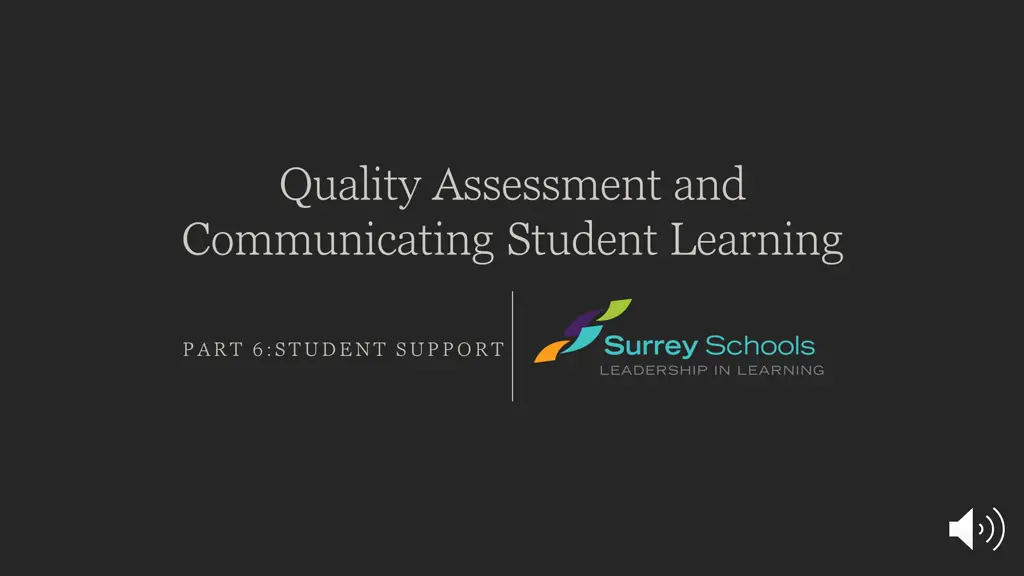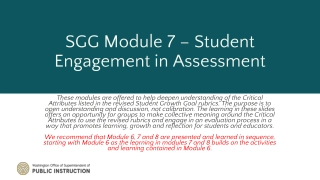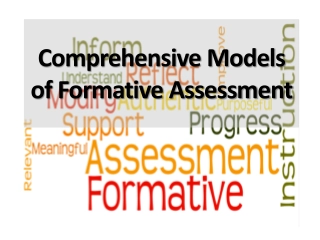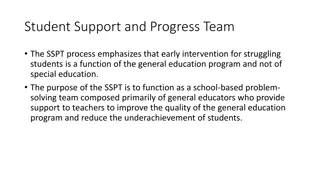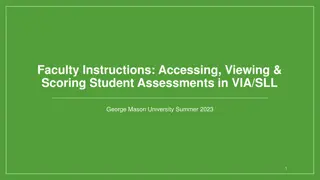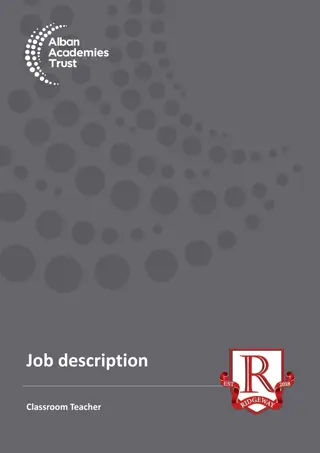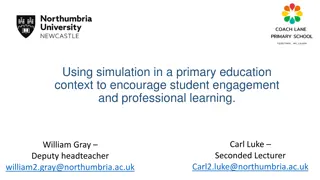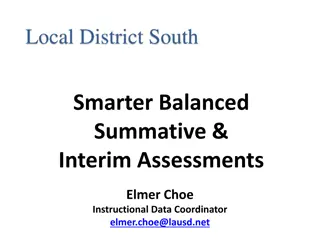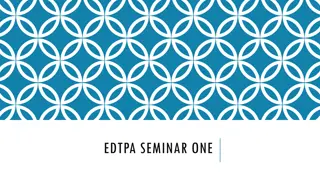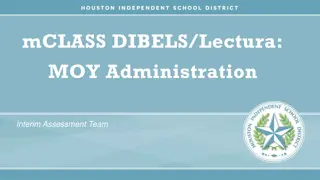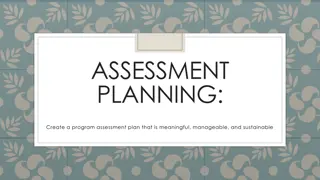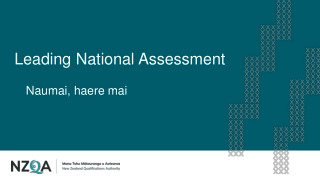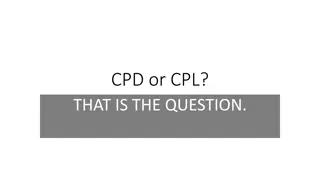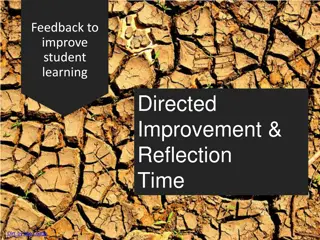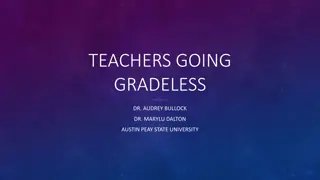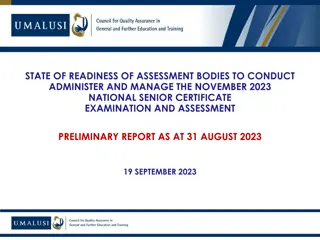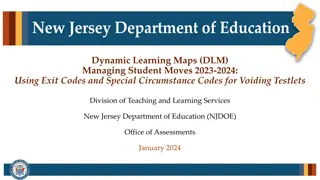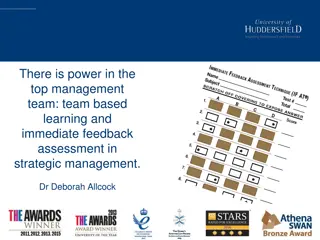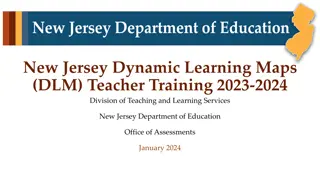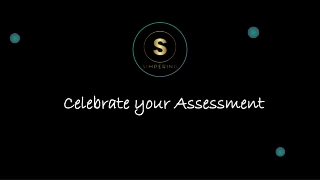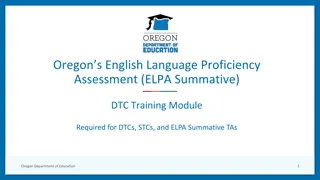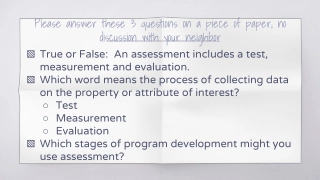Quality Assessment and Communicating Student Learning
Assessment and reporting practices that are inclusive of all students. It emphasizes the importance of personalized learning, transparency in assessments, targeted supports and goals, collaboration between teachers, and a student-centered approach.
- inclusive assessment
- reporting practices
- personalized learning
- transparency
- targeted supports
- collaboration
- student-centered approach
Download Presentation
Please find below an Image/Link to download the presentation.
The content on the website is provided AS IS for your information and personal use only. It may not be sold, licensed, or shared on other websites without obtaining consent from the author. Download presentation by click this link. If you encounter any issues during the download, it is possible that the publisher has removed the file from their server.
Presentation Transcript
Quality Assessment and Communicating Student Learning PART 6:STUDENT SUPPORT
Included in Part 6 Inclusion Assessment and reporting for all students New Reporting Order ELL Student with IEPs (all, few, some)
Learning ultimately supports the well- being of the self, the family, the community, the land, the spirits, Each learner s uniqueness is valued and appreciated. Each learner is perceived as having specific gifts that can be nurtured and supported to flourish. and the ancestors. -FPPL
Assessment and Reporting for All Inclusive education system in which all students, regardless of their identities, background, needs, abilities or circumstances, are fully participating members of a community of learners. Students are entitled to equitable access to learning, resources, and the pursuit of excellence in all aspects of their educational programs. Assessment and reporting practices must be inclusive of all students and reflect the histories, lived experiences, perspectives/worldviews, and cultures, and strengths. Inclusive assessment practices allow students multiple opportunities to practice and demonstrate knowledge and competencies, which are assessed through observations, conversations, and multi-modal demonstrations of learning (Triangulating Evidence of Learning)
Multiple Pathways Importance of Multiple Pathways: Importance of Multiple Pathways: Personalized approach to learning, access to curriculum and skill development, support individual needs and diverse abilities Transparency in Assessments: Transparency in Assessments: Defined proficiency scales and success criteria, Providing more access points for learners, Adapting scales to cater to diverse needs and abilities Targeted Supports and Goals: Targeted Supports and Goals: Varying levels of support needed, alternative methods for demonstrating learning (triangulating evidence of learning), individualized and replacement goals for additional assistance Collaboration between Teachers: Collaboration between Teachers: Classroom and support teachers working together, understanding and meeting students' different needs, guidance for personalized learning paths Student Student- -Centered Approach: Centered Approach: Involving students and caregivers in the process, meeting students where they are, empowering students to demonstrate learning in their unique way
Reporting for English Language Learners (ELL) Reporting Requirements for ELL Students: Same as other students following learning standards Proficiency Scale and Letter Grades: Appropriate if student can meet learning standards of the course Students Not Meeting Learning Standards Due to Language Proficiency Level: Not appropriate to use proficiency scale or letter grades Description of student's abilities, what they can do Areas needing improvement Recommendations for support and further learning More information to come for this scenario
Reporting on Language Acquisition within the Descriptive Comment Framework Engagement Language Acquisition (Student) enthusiasm and willingness to take on new challenges in the language-learning process demonstrates (his/her/their) dedication to improving (his/her/their) English skills. (Student) receives differentiated instruction within the classroom from an ELL specialist in the area of English Language and Literacy Development and is making _____________progress in (choose one or more of the domains- oral language, reading and/or writing). (Student) is (include student strength(s), and what they can do, and is working on (include next steps for improvement. Strengths Strengths Next steps
PAUSE With the understanding that limited language does not necessarily mean limited knowledge, how can we authentically assess ELL students? What alternative ways can we capture evidence of learning, and what students actually know?
An Individualized Education Plans (IEP) is required for any student who has a Ministry of Education Special Education Designation. An IEP is a document that describes the students' profile, strengths and support needs, and goals for development in areas of their education that differ from the BC Curriculum. Pathways What are IEPs? Who needs them?
Language of ALL, SOME, FEW All- Universal supports Some Targeted (Essential) supports Few- Replacement curricula
PAUSE What are some of the most common universal supports that student access in your classroom?
Example Scenario Deepak is a grade 8 student with a learning disability. His psycho-educational assessment indicates a significant impairment in processing speed but average academic skills. Deepak's IEP lists extra time on assignments, projects and tests. Since extra time is meant to address a barrier identified in his psychoeducational assessment these are targeted (essential) supports. Deepak receives extra time per his IEP. With these supports Deepak is performing in the proficient range on the proficiency scale.
Evaluation in Reference to Individualized Learning Goals (Replacement Goals) Students with disabilities and diverse abilities whose learning is supported by individualized learning goals must have an IEP that outlines their goals and the methods for evaluating the goals. These learning goals are set by teachers in consultation with students, parents, caregivers, and other student support team members (e.g., Specialist Teachers, physiotherapist, speech pathologist, psychologist, educational assistant, occupational therapist) and are recorded in the student s IEP. Students receive feedback in a manner that is identified in the individualized learning goals of their IEP (e.g., Proficiency scales, letter grades and percentages, descriptive feedback). Communication of student learning aligns with the school and/or district s regular reporting periods and formats. It is also important to note that these students' learning experiences in the classroom should still be connected with the same content and competencies as their peers as their peers are exploring but with modifications (replacement goals) to meet their unique needs.
Creating Replacement Curricular Goals Teachers, in collaboration with the student and the student's Case Manager (most often BASES teachers), look at the BC curricular competencies of the grade level and area of learning and pick a few (1-3) specific competencies to focus on. An individualized objective is created in relation to the curricular competency of focus. This is set as something attainable for the student and specific criteria for evaluating of growth in this competency is clearly defined. This individualized objective is the replacement goal. The student has access to and engages in all learning activities within the area of learning but is only being evaluated on progress toward the specific replacement curricular goals, not the full BC curriculum for the area of learning.
Communicating Student Learning in Relation to Replacement Curricular Goals Reporting should clearly indicate that evaluation and assignment of a proficiency scale indicator or percentage/letter grade is in relation to IEP replacement curricular goals and not BC Curriculum in the area of learning. This is done via report card comments and descriptive feedback. An individualized reporting form can be utilized to fit replacement curricular goals into standard reporting structures as well as to make this communication more meaningful and authentic. Include strength-based feedback and areas for further growth.
Example Scenario 1 Greg is a grade 9 student with Mild Intellectual Disabilities (K-designation) His psycho-educational assessment describes him as a capable young man with strengths in physical motor skills, sports and verbal comprehension. His challenges include struggles with working memory and critical thinking. Greg is working towards a replacement curriculum in his "academically heavy" courses including Social Studies and Science, and is currently working on literacy, numeracy and life skills type goals in an IEP related BASES block. He is working towards the standard BC curriculum in areas of learning such as PE, Art, and Foods. Greg will be working towards an Evergreen School Leaving Certificate as he moves into his graduation program in years 10-12.
Example Scenario 2 Kai is a Grade 10 student with Fetal-Alcohol Syndrome (D-designation) and a Moderate to Profound Intellectual Disability (C-designation) Kai s ability to plan and execute any task is severely impacted by their diagnosis. They require constant prompting and reminders to complete any tasks. They rely heavily on the use of visual supports and direction from a Teacher or Inclusive Education Support Worker. Kai's fine motor skills are a relative strength, and they enjoy drawing and painting. Kai is on an Evergreen School Leaving Certificate (Modified) program. While the majority of Kai s educational program is very individualized with life skills goals via IEP and BASES programming (ie. personal hygiene, safety in the community, and social/emotional regulation). Kai is also enrolled and included in an Art 10 class which they are able to attend to for approximately 30mins per class.
PAUSE What has your experience with IEP replacement (modified) goals been in the past? How is this similar or different to what the last 2 examples given here?
In Summary Most students with IEPs are working towards regular class curriculum and are utilizing universal and targeted (essential) supports to create equitable access to the curriculum and the assessment of their learning. These student are working towards regular Dogwood Diploma graduation Few students (with diagnosed intellectual disabilities) (with diagnosed intellectual disabilities) are working towards replacement curricular goals that are created for them to access curricular areas of learning at their own level. The reporting of these goals utilize proficiency scale language for grade 8 and 9, and letter grade/percentage for grade 10-12, with clearly defined criteria, and clearly indicates class report/evaluation is not on standard BC curriculum in the area of learning. These student are most likely working towards an evergreen school leaving certificate (not regular dogwood diploma) Consultation and Collaboration with Case Managers is key in developing the right plans for students with IEPs.
Further Questions/Clarification and Support? Naginder Sanghera LST Helping Teacher sanghera_n@surreyschools.ca For student working within the LST framework of your school Greg England Special Education Helping Teacher england_g@surreyschools.ca for students working within the B.A.S.E.S. framework of your school
